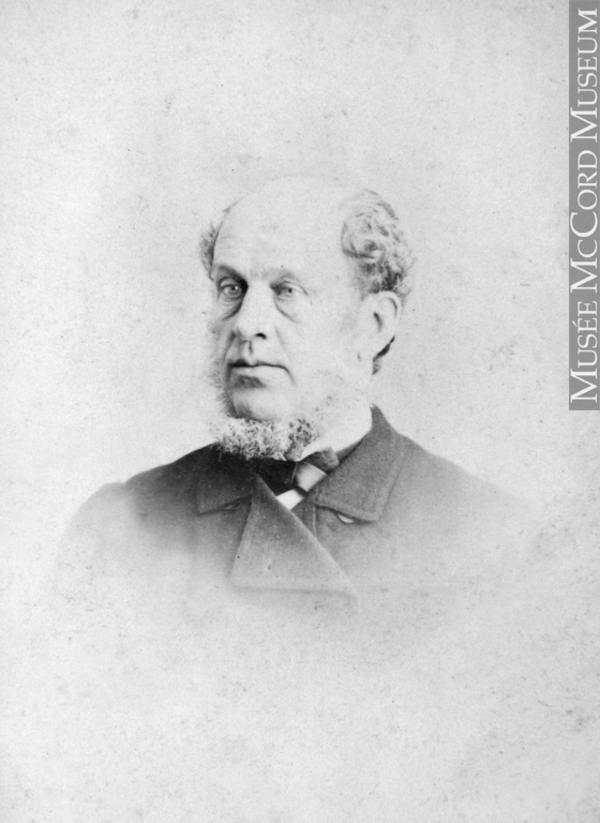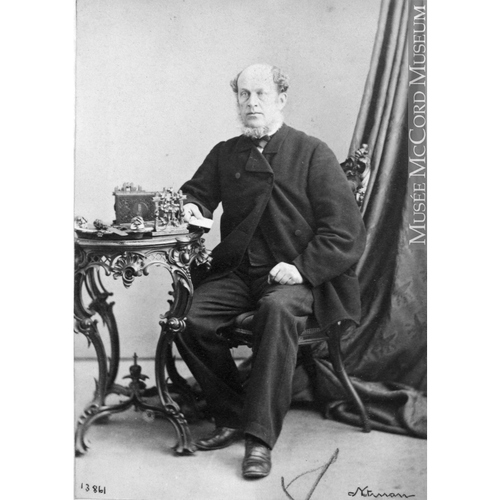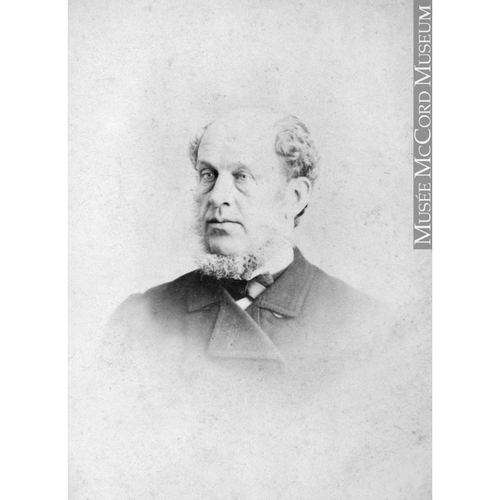
Source: Link
HAY, ROBERT, cabinet-maker, furniture manufacturer, and politician; b. 18 May 1808 in the parish of Tibbermore, Newbigging (Tayside), Scotland, the youngest child of Robert Hay and Bettrice Henderson; m. 18 Nov. 1847 in Toronto, Canada West, Mary Dunlop (1828–71), of Glasgow, Scotland, and they had eight children; d. 24 July 1890 at Toronto.
Robert Hay began working as an apprentice cabinetmaker in Perth, Scotland, at age 14. In September 1831 he immigrated with his family to York (Toronto) where shortly thereafter his parents died of cholera. Hay and another Toronto cabinet-maker, John Jacques, entered into partnership in 1835 to produce cabinetware, purchasing William Maxwell’s shop on King Street. The firm of Jacques and Hay, and its successor in 1871, Robert Hay and Company Limited, had its principal outlet in the same city block until the company was dissolved in 1885. From a small operation employing two artisans and producing goods to order, the partners built their company into the leading furniture manufacturer in the Province of Canada by 1850. The firm maintained its primacy until at least 1882, when the last in a series of major fires temporarily crippled its manufacturing capacity.
The growth in the volume of production of the firm was accompanied by a profound transition from the artisan mode to that of highly mechanized mass production of standardized furniture parts. Jacques and Hay were among the first in the Canadas to employ steam-power for their machinery, and in 1854 set up a branch plant and sawmill in the village of New Lowell in Simcoe County, Canada West, to manufacture components for items of furniture. The village of New Lowell was built on part of the 1,100 acres the company held in Sunnidale Township. Although the original plan to attract a variety of industries to the site failed, Jacques and Hay built their own plant as well as employees’ houses, an inn, a schoolhouse, a church, and a railway station for the Toronto, Simcoe and Lake Huron Union Rail-road of which Hay was one of the original promoters and which ran through the property.
By the 1860s Jacques and Hay were exporting to Glasgow large numbers of chairs and assorted wooden pins for the textile industry. The company reported annual sales of $500,000 in 1870, and two years later the wholesale trade of Robert Hay and Company in chairs alone was nearly $150,000; no other furniture manufacturer in Ontario had anything approaching this volume of trade. The company was the largest employer in the Canadian furniture industry, with nearly 500 employees on its pay-roll in the 1870s.
Although it was the leader in mass production furniture, the company maintained a reputation for the high quality of its solid walnut cabinetware throughout nearly 50 years of operation. Machine production eliminated much of what had previously been the artisans’ work, but many operations still required craftsmanship of the first order. It appears likely that the firm distinguished between the production of elegant drawing-room pieces and higher volume cottage furniture.
Hay was the entrepreneur of the business, while Jacques supervised the daily operations of the factory and warehouse in Toronto; after Jacques’s retirement in 1870, the junior partners, George Craig and Charles Rogers, assumed his responsibilities. The peripatetic Hay spent much time cultivating business and political acquaintances, contacts which were undoubtedly at the root of his firm’s persistent winning of contracts to supply imperial, provincial, and local governments with military, school, and hospital furniture. Severe credit shortages, currency restraints, and the market fluctuations of a staple-producing economy compelled the firm to turn intermittently to making interior fittings for such notable buildings as Osgoode Hall, University College, and the Queen’s Hotel in Toronto, and at least one early steamer. The company supplied a great deal of timber from its stands near New Lowell to Ontario railways during the building boom of the post-confederation years, and it shipped millions of board feet to Chicago and Troy, N.Y. During slack periods the firm also produced a wide variety of wooden commodities such as broom handles and clothes pins, as well as haircloth for furniture coverings and mattress filling.
In pursuit of a favourable business climate Hay was an early advocate of tariff protection. He participated in the founding of the Association for the Promotion of Canadian Industry in 1858, and was active in its successor in 1866. He was also elected for Toronto Centre in the federal election of 1878 as a Liberal-Conservative and an advocate of the National Policy defeating John Macdonald. He held the seat until the dissolution of parliament in January 1887, but was an extremely reticent member in the House of Commons. In local politics he was much involved with politicians in lobbying for development important to New Lowell such as a post office, a telegraph, and a railway stop.
While garnering a personal fortune, Robert Hay helped to propel the Ontario furniture industry into a new age of mass production and he was among the first to exploit the possibilities in exporting manufactured products. But the firm did not survive his participation in it. When he retired in 1885, he insisted on winding up the business because of disagreement over its valuation. His only surviving son, John Dunlop, was trained as a merchant and gentleman farmer and took no active interest in the furniture business, and his sons-in-law were bankers or merchants.
Hay’s interests had shifted in later life. He had been a founder and provisional director of the St Lawrence Bank in 1872 and he was elected a director of the Credit Valley Railway in 1875 and president of the Canadian Lumber Cutting Machine Company. In the 1880s he speculated in lands in the North-West Territories, briefly operated a wholesale lumber business in Medonte Township with his son, and spent increasing amounts of time with his prize-winning livestock on his farm near New Lowell.
As a leading Toronto business man, Hay had been active in the community as a member of the St Andrew’s (Presbyterian) Church, the St Andrew’s Society, and the mechanics’ institute. Upon his death in July 1890, his estate, valued at nearly $350,000, was divided among his four surviving children.
AO, RG 31, Declarations of partnerships, 1: nos.250, 377; 2: nos.3527, 4581. CTA, Toronto assessment rolls, St George’s Ward, 1835–90. Land Registry Office for the Division of Toronto, Deeds, instrument no.4198B. Royal Ontario Museum (Toronto), Canadiana Dept., Sigmund Samuel Coll., S. M. Smith, “Jacques and Hay, 1835–85, cabinet-makers” (typescript, n.d.). Scottish Record Office (Edinburgh), Tibbermore parish register, 1808. Simcoe County Arch. (Minesing, Ont.), Jacques and Hay Furniture Company papers. Simcoe County Registry Office (Barrie, Ont.), Abstract index to deeds, Medonte Township (mfm. at AO, G.S. 5435); Sunnidale Township (mfm. at AO, G.S. 5511–13). Toronto Boroughs and York South Registry Office (Toronto), Abstract index to deeds (mfm. at AO, G.S. 6033–34). York County Surrogate Court (Toronto), no.8052, will of Robert Hay, 6 Sept. 1890 (mfm. at AO). Isaac Buchanan, The relations of the industry of Canada, with the mother country and the United States . . . , ed. H. J. Morgan (Montreal, 1864). Can., House of Commons, Debates, 1878–83, 1891. Banner (Toronto), 16 Feb. 1844. Daily Leader (Toronto), 30 Dec. 1854. Globe, 1847–56, 2 Feb. 1882. Toronto Daily Mail, 1886–90. Toronto World, 25 July 1890. Canadian biog. dict., I: 192–96. Commemorative biog. record, county York. CPC, 1879. Cyclopædia of Canadian biog. (Rose, 1886), 293. Joan MacKinnon, A checklist of Toronto cabinet and chair makers, 1800–1865 (Ottawa, 1975). Middleton, Municipality of Toronto. Philip Shackleton, The furniture of old Ontario (Toronto, 1973).
Cite This Article
Stanley Pollin, “HAY, ROBERT,” in Dictionary of Canadian Biography, vol. 11, University of Toronto/Université Laval, 2003–, accessed December 31, 2025, https://www.biographi.ca/en/bio/hay_robert_11E.html.
The citation above shows the format for footnotes and endnotes according to the Chicago manual of style (16th edition). Information to be used in other citation formats:
| Permalink: | https://www.biographi.ca/en/bio/hay_robert_11E.html |
| Author of Article: | Stanley Pollin |
| Title of Article: | HAY, ROBERT |
| Publication Name: | Dictionary of Canadian Biography, vol. 11 |
| Publisher: | University of Toronto/Université Laval |
| Year of publication: | 1982 |
| Year of revision: | 1982 |
| Access Date: | December 31, 2025 |




